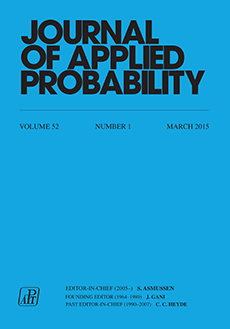Abstract
During the course of a day an individual typically mixes with different groups of individuals. Epidemic models incorporating population structure with individuals being able to infect different groups of individuals have received extensive attention in the literature. However, almost exclusively the models assume that individuals are able to simultaneously infect members of all groups, whereas in reality individuals will typically only be able to infect members of any group they currently reside in. In this paper we develop a model where individuals move between a community and their household during the course of the day, only infecting within their current group. By defining a novel branching process approximation with an explicit expression for the probability generating function of the offspring distribution, we are able to derive the probability of a major epidemic outbreak.
Citation
Peter Neal. "A household SIR epidemic model incorporating time of day effects." J. Appl. Probab. 53 (2) 489 - 501, June 2016.
Information





